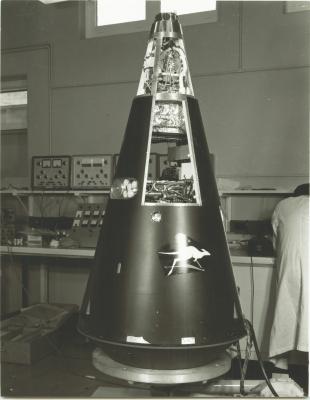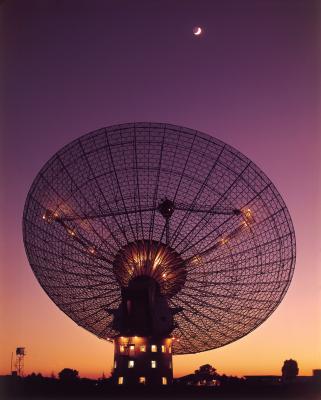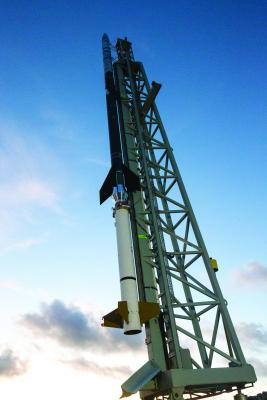Australia has played an important role in the history of space exploration. Since the 1950s, our nation has been involved in rocket launches, space tracking and other activities.
On this page and through the downloadable resource, explore significant milestones in the Australia's rich space history.

Australian Space Milestones
Caption: Andy Thomas with some Australian souvenirs during his 1996 spaceflight.
Representing Australia is filled with opportunities to propel our nation's science and technology forward in the global space arena and to raise the level of aspiration for the next generation.
~ Australian Astronaut Katherine Benell-Pegg
1957
1957
The International Geophysical Year (IGY) was a global scientific research program operating from July 1957 to December 1958. One area of interest was the relationship of the Earth to the space environment.
Both the USA and USSR planned to launch satellites during the IGY and Australia agreed to host two tracking stations at Woomera Rocket Range, South Australia. These stations used optical and radio tracking techniques to support the US Vanguard satellite program. This was the beginning of space tracking in Australia, which is our longest continuous space activity.
In addition, Australia and the UK both developed sub-orbital sounding rockets, which were launched from Woomera to study the upper atmosphere during the IGY. The Australian sounding rocket program continued until 1975, while the UK program used Woomera until 1979.
Pictured is an Australian-developed Long Tom sounding rocket, operational from 1958-1966.

1964-1970
1964-1970
Photo credit: Defence Science and Technology Group
The European Launcher Development Organisation (ELDO) was a predecessor of the European Space Agency (ESA). A consortium of six European countries, ELDO was formed in 1962 to develop an independent launch capability for Europe.
The UK provided the first stage of the rocket, France the second stage, West Germany the third stage and Italy the test satellite. Belgium and the Netherlands provided electronics and tracking. Australia provided launch facilities at Woomera, also becoming an ELDO member. ELDO’s Europa satellite launcher was the largest rocket launched in Australia to date.
There were ten ELDO test flights from Woomera between 1964 and 1970, but the organisation never managed to put a satellite into orbit. The program moved to the French launch site at Kourou, French Guiana, after 1970, but ELDO collapsed a few years later and was succeeded by the European Space Agency in 1975. As a former ELDO member, Australia was offered ESA membership, but declined.
The picture shows the first launch of the British Blue Streak rocket, which formed the Europa vehicle’s first stage.

1967-1970
1967-1970
WRESAT under construction at the WRE.
Photo credit: Defence Science and Technology Group
Australia’s first satellites were launched in 1967 and 1970. WRESAT-1 (WRE Satellite) was developed by the Weapons Research Establishment (WRE), which managed the Woomera Range, and the University of Adelaide. WRESAT was launched from Woomera on 29 November 1967, using a rocket donated by the US. The flight made Australia one of the earliest nations to launch its own satellite. WRESAT operated for five days.
Although designated WRESAT-1, the satellite had no successor, as the government of the day decided not to proceed with an Australian space program.
Launched 23 January 1970, Australis-OSCAR 5 (AO-5) was constructed by students at Melbourne University. It was the first amateur radio satellite built outside the US. AO-5 was built using easily sourced parts, such as antennae made of flexible steel tape from a hardware shop.
Weighing only 17.7 kilograms, AO-5 was the first amateur satellite to use a passive magnetic attitude stabilisation system, and a command system to turn its transmitter on and off. It transmitted for about six weeks, but the satellite remains in orbit.

1968-1972
1968-1972
Parkes radio telescope, Murriyang.
Photo credit: CSIRO
By 1969, Australia was host to the largest number of NASA tracking stations outside the United States, supporting NASA’s three networks for planetary exploration, human spaceflight and Earth-orbiting satellites. To support the Apollo lunar program, NASA established a station at Honeysuckle Creek (HSK) in the ACT.
From 1968, HSK supported the Apollo 7 and 9 Earth-orbiting missions, and the lunar missions Apollo 8, 10-17. HSK worked with the deep space station at Tidbinbilla to provide communications with the Apollo Command and Lunar Modules when they were operating separately at the Moon.
During Apollo 11 in July 1969, HSK worked with CSIRO’s Parkes Radio Telescope (its Indigenous name is Murriyang) to bring television coverage of the Moon landing to the world. The first 8 minutes and 50 seconds of Armstrong’s Moonwalk, including his first steps on the Moon, were received at HSK.
The higher-quality signal from Parkes took over once the Moon rose high enough there for good signal reception. It provided the rest of the Moonwalk coverage. The two stations also played a vital role in the rescue of Apollo 13.

1984
1984
Photo credit: NASA
The first Australian-born person to make a spaceflight was oceanographer Dr Paul Scully-Power, a Payload Specialist aboard Space Shuttle mission STS 41G in October 1984.
Payload Specialists were not permanent members of the NASA astronaut corps and received shorter training for specific missions. At the time of his spaceflight, Scully-Power was a US citizen, a civilian US Navy employee, and he flew as a US astronaut.
During his flight, Scully-Power made visual oceanographic observations of three-quarters of the world’s oceans. He observed ocean current features that could not be detected from remote sensing satellites in higher orbits and made important discoveries about spiral eddies (large-scale circular ocean currents).
Improved observations of ocean eddies enabled a better understanding of large-scale ocean movements and their effects upon the world’s weather systems. The discoveries made by Scully-Power during his space mission were of significant for oceanography, meteorology, and other Earth sciences.
The picture shows Scully-Power during pre-launch preparations for his flight.

1985-1995
1985-1995
Photo credit: NASA
Between 1985 and 1995 the Australian Government looked to develop a local space industry, establishing the Australian Space Office (ASO) in 1987. CSIRO’s Office of Space Science and Applications (COSSA) was established in 1984 to carry out space-related projects.
COSSA became involved in the development of remote sensing instruments for satellites. Australian-designed components flew as part of the Along Track Scanning Radiometer (ATSR) instruments on the European Space Agency’s ERS 1 and 2 radar remote sensing satellites (launched 1991 and 1995) and the Advanced ATSR on ESA’s Envisat (launched 2002).
The ASO supported the development of the Endeavour Space Telescope, a project to space-qualify an Australian ultraviolet detector. Endeavour flew on Space Shuttle missions STS 42 (1992) and STS 67 (1995).
The Aggregation of Red Cells (ARC) experiment, an independent Australian medical research payload, was carried on Space Shuttle flights STS 51C (1985) and STS 26 (1988).
It examined the effect of microgravity on normal and diseased red blood cells, looking for any differences that could provide keys to treatment or cure for particular diseases.

1996-2005
1996-2005
Photo credit: NASA
Dr Andrew (‘Andy’) Thomas was the first Australian-born NASA Mission Specialist. Mission Specialists were permanent members of the astronaut corps, responsible for experiments and research programs carried out on Shuttle missions.
Thomas made four spaceflights, totalling just over 177 days in space. His first flight was STS 77 (1996) aboard the Space Shuttle Endeavour. Changes in US citizenship laws enabled Thomas to reapply for Australian citizenship and he made his second spaceflight as a dual US-Australian citizen. In 1998, Thomas became the last US astronaut on the Russian Mir space station, spending 141 days in space.
Between 2001 and 2003, Thomas served as Deputy Chief of the Astronaut Office. His third flight, in 2001 on STS 102, included his first spacewalk. Thomas spent six and a half hours installing components on the exterior of the ISS.
Thomas’ final space mission was STS 114, in July 2005, the first flight following the loss of Space Shuttle Columbia. He tested and evaluated new procedures for flight safety, and inspection and repair techniques for the Shuttle’s thermal protection system.
The picture shows Andy Thomas with some Australian souvenirs during his first spaceflight in 1996.

2002
2002
Photo credit: Glen Nagle
FedSat (Federation Satellite) was a 58kg technology demonstrator microsatellite intended to celebrate the centenary of Australian Federation in 2001. It was developed by CSIRO’s Cooperative Research Centre for Satellite Systems (CRCSS), which included six Australian universities, four companies and the Defence Science and Technology Organisation as partners. FedSat carried six payloads provided by Australian and international partners.
The communications payload included a Ka-band transponder, making FedSat the world’s first microsatellite capable of operating in that band. The High Performance Computing Experiment used a reconfigurable computer that was the first of its kind to be flown in space.
FedSat also carried a ‘cultural time capsule’ on CD, which included songs and recorded statements from Australian school children about their visions for Australia’s future. Japan provided FedSat’s launch as a centenary gift, although, due to construction delays, it was not launched until 14 December 2002.
The CRCSS operated FedSat until 2005, with the Department of Defence then operating the satellite until its battery failed in 2007.
This picture shows an artist’s impression of FedSat in orbit.

2018
2018
Photo credit: Australian Space Agency
Announced by the Government on 25 September 2017, the Australian Space Agency commenced operations on 1 July 2018. The Agency is a non-statutory, whole-of-government entity located within the Department of Industry, Science and Resources as a separately branded function.
The Australian Space Agency’s purpose is to transform and grow a globally respected Australian space industry that lifts the broader economy, and inspires and improves the lives of Australians. The front door for Australia’s international engagement on civil space, the Agency operates as the national priority-setting mechanism for the civil space sector. It provides whole-of-government coordination of civil space matters and is the primary source of advice to the Australian Government on civil space policy.
Under this broad mandate, the Agency has six primary responsibilities: Providing national policy and strategic advice on the civil space sector; coordinating Australia’s domestic civil space sector activities; supporting the growth of Australia’s space industry and the use of space across the broader economy; leading international civil space engagement; administering space activities legislation and delivering on our international obligations; inspiring the Australian community and the next generation of Australia’s space workforce. Pictured is the Australian Space Agency Mission Patch.

2020
2020
Photo credit: NASA
In September 2019, the Prime Minister announced the $150 million Moon to Mars initiative to support Australian businesses and researchers to participate in NASA’s inspirational plan to return to the Moon and on to Mars.
The following year (2020) during the 71st International Astronautical Congress, Australia became one of the seven founding signatories of the Artemis Accords. The Accords establish a practical set of principles to guide space exploration cooperation among nations participating in NASA’s 21st-century lunar exploration plans. These international partnerships will play a key role in achieving a sustainable and robust presence on the Moon later this decade while preparing to conduct a historic human mission to Mars.
The image shows the logo of the Artemis Program.

2021
2021
Photo credit: Australian Space Agency
The Agency will collaborate with NASA to send an Australian-designed, built and operated semi-autonomous rover to the lunar surface later this decade.
The rover will collect lunar soil, known as regolith, and will work with NASA to develop key capabilities that lead to a sustainable human presence on the lunar surface.
Australia has developed world-leading capabilities in remote operations as part of its resources sector: remote operations and robotics technology have huge potential for the future of space exploration.
Seen here is the hero image for the G’Day Moon campaign, promoting the Trailblazer program.

2022
2022
Photo credit: Equatorial Launch Australia
Between 27 June and 11 July 2022, three suborbital sounding rocket launches took place on behalf of NASA at the Arnhem Space Centre (ASC), operated by Equatorial Launch Australia (ELA). They were the first NASA launches from a commercial facility outside the US, and the first NASA rockets launched from Australia since 1995, when launches were conducted from Woomera.
The ASC is located near Nhulunbuy, in the Northern Territory, on the lands of the Yolngu people. Traditional Owners were consulted as part of the launch approval process and local Indigenous contractors worked on the construction of the facility.
The three NASA missions investigated heliophysics, astrophysics, and planetary science phenomena only observable from the southern hemisphere.
The image shows one of the Canadian-built Black Brant IX rockets used in the launch campaign.

2023
2023
Photo credit: SpaceX
On 2 December 2023, the SpIRIT (Space Industry Responsive Intelligent Thermal) satellite launched on SpaceX’s Transporter-9 mission. It has been designed to fly in low Earth orbit for 2 years, demonstrating the performance and endurance of the Australian-made technology on board. SpIRIT is a cubeSat, a type of nanosatellite built using 10cm cube units. Six of these units feature in the SpIRIT design, making it roughly the size of a shoebox and just 11.5kg in weight. The University of Melbourne led an all-Australian consortium to develop the satellite. The project received funding support from the Australian Space Agency. SpIRIT is the first Australian satellite to carry a foreign space agency’s scientific instrument as its main payload - the Italian Space Agency’s HERMES X-ray detector.
This image shows SpIRIT lifting off from Vandenberg Space Force Base in California, USA, aboard a Falcon 9 rocket.

2023-24
2023-24
Photo credit: European Space Agency.
In 2024, the Australian Space Agency’s Katherine Bennell-Pegg became the first person to complete training as an astronaut under the Australian flag.
Her training at the European Astronaut Centre in Germany from 2023-2024 covered a wide range of areas. This included operating experiments in low gravity during parabolic flights, medical training, space station robotic arm simulations, survival training, foreign languages, human centrifuge, hypoxia and hypobaric awareness, diving in the neutral buoyancy facility to practice spacewalking and more.
Katherine is now fully qualified for missions to the International Space Station. She has also developed knowledge and connections that can help create opportunities for Australian scientists, engineers and innovators to be part of major international missions.
The image shows Katherine in a flight suit during her training with the European Space Agency in Germany.

